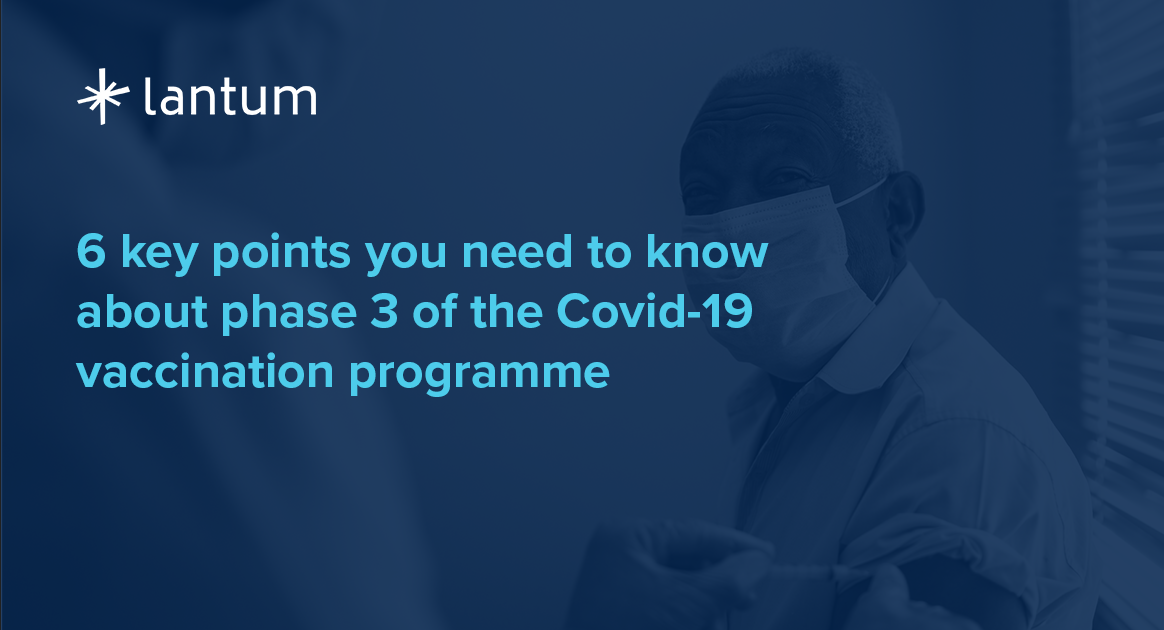Workforce Planning, covid-19, coronavirus
6 key points you need to know about phase 3 of the Covid-19 vaccination programme
As phase 3 of the Covid-19 vaccination programme kicks into action across the UK, implementing changes based on lessons learned throughout phases 1 and 2 is key to smooth delivery of the vaccines over the coming months.
To support vaccination sites across the UK, the NHS and Joint Committee of Vaccination (JCVI) and Immunisation published guidance on booster vaccines, as well as advice on planning for phase 3 (Autumn / Winter).
To help you get your booster sites up-and-running as quickly as possible, we’ve reviewed the guidance and have pulled out the key information you need to know.
In their guidance, JVCI strongly recommends that your sites should offer both the Covid-19 and Winter Flu vaccinations, to maximise protection for those most vulnerable. The people who should be encouraged to get both vaccines are:
- Adults aged 16 and over who are immunosuppressed
- Those living in residential homes for older adults
- All adults aged 70 and over
- Adults aged 16 and over who are considered clinically extremely vulnerable
- Frontline health and social care workers
After the above groups of people have vaccinated (as much as possible), you should then offer the next group of people the two vaccines:
- All adults aged 50 and over
- Adults aged 16-49 who are in an influenza or Covid-19 at-risk group
- Adult household contacts of immunosuppressed individuals
The JVCI has suggested that these two stages of phase 3 should be completed by 17th September 2021, and should be delivered as quickly and safely as possible.
In phases 1 and 2, approximately 3.5m vaccinations were delivered on a weekly basis. Phase 1 helped deliver this through general practice, whereas phase 2 was driven more through the standing up of community sites, e.g. pharmacies.
In the guidance provided by the NHS, they’ve suggested that, to provide resilience and ease pressure on your workforce, you should spread capacity across all your sites. They anticipate that, at this time of year, it might be hard for general practice to deliver up to 75% of the vaccines. With this in mind, you should plan for 40-75% of vaccines to be delivered by general practice, and the rest should be delivered by your other sites, be that community pharmacies or other.
It’s worth noting that the NHS has committed to opening up an additional 1,000 community pharmacy sites, subject to interest and need. So, if you feel that accessing these additional resources would benefit your region, you should speak with them to tap into this offer.
3.Consider the best delivery approach for your population’s needs
A core goal of phase 3 is to reach the underserved communities, and to use learnings from phases 1 and 2 to achieve this. In the guidance, the NHS has suggested that you should optimise the following avenues to access the harder-to-reach members of your community:
- Community pharmacy
- Pop ups
- Mobile units
Dr Ollie Hart, a Sheffield-based GP partner, made the news earlier this year, as he cycled to the homes of vulnerable people to deliver their vaccine doses. Whilst it’s a more out-of-the-box approach, the idea of bringing the vaccine to the population is worth considering, especially at this phase of the programme.
The NHS recognises the critical need to have sufficient workforce in place to deliver both the Covid-19 and Winter Flu vaccines in tandem. To support you with successful delivery of this, they suggest that you should maximise the use of volunteers as much as possible, and they have a centrally-sourced workforce that you can access, that includes non-registered, trained vaccinators.
In a recent webinar that focused on ARRS roles, Brenda Connolly, a nurse and clinical director at South Southwark PCN, shared how she approached building a varied team to deliver their vaccinations, and she described how managing your vaccination team is like growing a garden. You can hear her ideas and insights here.
Insights from phases 1 and 2 show that there have been considerable benefits to using commercial estates to deliver vaccines. With many of these estates now returning to their usual functions, the guidance advises that you should now maximise use of existing NHS estates and commissioned provider premises to keep the momentum going. You might find that continued use of some commercial estates is the most financially viable option and therefore, where possible, you should continue to use these premises.
From 1st September 2021, the advice on use of estates has been as follows:
- Maximise use of NHS estates and commissioned provider premises
- Use available Local Authority estates to backfill any gaps in NHS coverage
- Use commercial estates to further fill any gaps, meet specific capacity shortfalls, and better target those underserved groups.
6. Tap into available financial resources
As with phases 1 and 2, there are two streams of funding available to you to support your delivery of the programme:
- Regional programme resource funding
- Regional delivery funding
Where possible, you should tap into these financial resources to maximise staffing, sites and planning.
How Lantum can help
Since the vaccination programme kicked off, Lantum has worked with over 100 sites across the UK to create and fill their rotas, build and manage their banks of staff (both paid and volunteers), and - most importantly - vaccinate the population. To date we’ve filled over 114,000 shifts, and this number is increasing rapidly as the programme continues.
To extend our support to all sites across the UK, we are offering free use of our staff rota and scheduling tool to all sites new to Lantum.
With the ability to get you up-and-running in just one week, now is the perfect time to take advantage of this offer and start your phase 3 efforts smoothly.
Click here to learn more about the offer, and to start standing up your sites for free through Lantum.


